My Research
Gabriel is a registered counselling psychologist and a BACP accredited counsellor. Alongside her research work with BACP, she is Clinical Director of a social enterprise that delivers specialist NHS psychological therapy.
In collaboration with fantastic BACP colleagues I co-ordinate and contribute to the research that underpins BACP’s specialist counselling competence frameworks and curricula. The frameworks are built on rigorous scoping reviews carried out in consultation with external training, research and practice experts. These free resources are guides to good practice and training standards. Four new frameworks we’re working on are counselling for addiction, relationships and psychological trauma and for adults affected by adoption.
My broader research work supports the development and use of novel qualitative methodologies for psychotherapy research. This interest came about when I wanted to design my doctoral thesis to interrogate the meaning of ‘client factors’ in common factors theory. Vague or ambiguous clinical concepts are rarely systematically questioned in psychotherapy theory, practice and research, perhaps in part because there isn’t a psychotherapy-amenable concept analysis tradition. I addressed this methodological gap by adapting and enhancing aspects of concept analysis approaches from nursing and social science to create a new approach I call ‘reformative concept analysis’. This approach can address a range of concept clarification questions, such as, ‘How is this concept described in research? Does this map on to lived experience?’ My article that explains this methodology in detail was recently published open access, Reformative concept analysis for applied psychology qualitative research.
BACP’s frameworks and curricula can be found on our BACP competence and curricula web page.
Research updates on suicide prevention
1 Negotiating tension
The study: A qualitative investigation explored how counsellors describe and comprehend their experiences of working with young people who are at risk of suicide. Counsellors across two clinical sites participated in focus groups.
The findings: A reflexive thematic analysis revealed two broad themes. First, counsellors explored their competence, compliance and accountability to institutional requirements of working with young people at risk of suicide as well as concerns with the standard approach. The second theme of ‘artful shifts and conversational openings’ captured counsellors’ various conceptualisations of suicide and counselling.
The takeaway: Working with youth at risk of suicide can be seen as a series of ongoing tensions that must be negotiated through critique and compliance of the standardised risk management approach.
For more information please see: Counselling Youth Who Are at Risk for Suicide: Working the Tensions.
2 Mentalization and mindfulness
The study: Building on the established efficacy of mindfulness therapy in alleviating anxiety and depression symptoms, the research aimed to determine whether combining mindfulness therapy with mentalization-based family therapy (MBFT) would lead to better outcomes for adolescents experiencing suicidal ideation and depression. One group of 40 adolescents received both MBFT and mindfulness therapy, while the other group of 40 received only MBFT.
The findings: MBFT alone positively influenced psychological health and reduced suicidal ideation. However, the combination of MBFT with mindfulness therapy produced more significant improvements.
The takeaway: Integrating mindfulness therapy with MBFT may offer a more effective therapeutic approach for adolescents with suicidal ideation and depression.
For more information please see: The impact of mindfulness therapy combined with mentalization-based family therapy on suicidal ideation in adolescents with depressive disorder: randomized intervention study.
3 Pluralism for actively suicidal clients
The study: The experiences of pluralistic counsellors and psychotherapists working with active suicide risk were explored through semi-structured interviews.
The findings: Four themes were identified. Theme one covered equal relationships, client collaboration, and the pluralistic counselling and psychotherapy (PCP) framework’s flexibility. Theme two captured PCP as supporting clients to become their own therapist, while ensuring therapists feel confident when working with this client group. Theme three explored how PCP supports the idea of therapists being responsible for delivering therapy the best they can, while maintaining clients’ responsibility on deciding whether they continue living. Theme four identified PCP as enabling therapists to bring their authentic self into sessions.
The takeaway: PCP can be an effective client-led approach for working with actively suicidal clients.
For more information please see: Pluralistic psychotherapists' and counsellors' experiences of working with actively suicidal clients: A qualitative interpretative phenomenological analysis.

